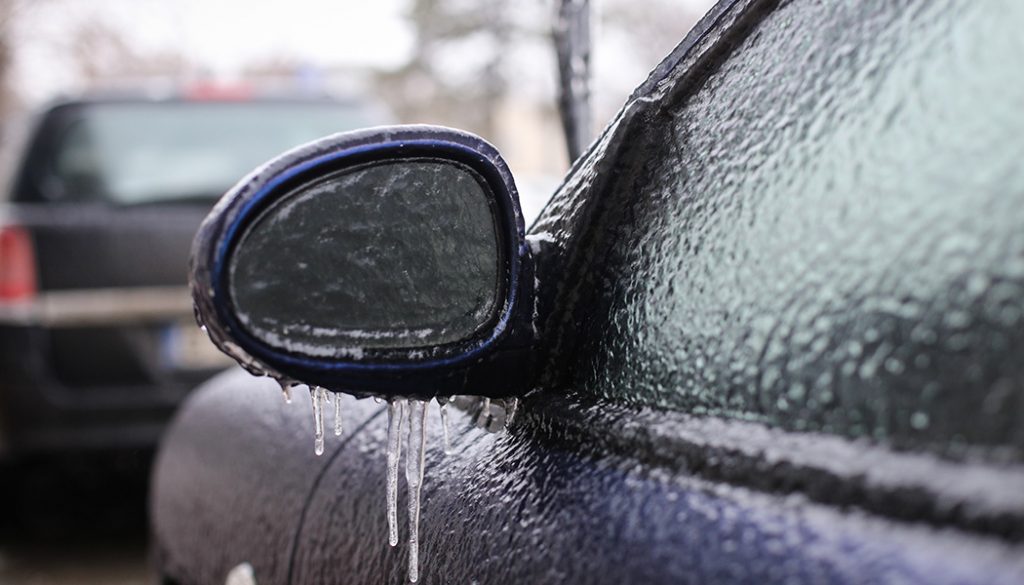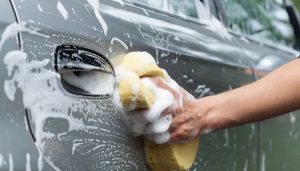Frozen Doors and Windows? How to Wash Your Car in Winter
Slush, sand, salt, snow, and ice. Winter driving comes with a whole different set of elements to deal with. None of them do any good for your vehicle. Unless the temperature drops well below freezing, you’ll be tempted to relegate yourself to driving a filthy car during the winter. You’ve probably thought, “What’s the point of washing my car? It’s just going to get dirty again in seconds.” Don’t give in. There’s much at stake if you don’t, so we show you how to wash your car in winter.
First, there’s pride of ownership. No one gets the warm-and-fuzzies when they walk up to their vehicle coated in road salt and a wave of sandy slush down the side. But a shiny paint job greeting you in the garage? That’s a shot of dopamine right there.
Then there are the benefits for your vehicle. A clean car can remain corrosion-free for much longer than a dirty one, especially in freezing weather. Melting snow and ice get into tiny crevices, freeze, and cause damage that you can’t see with the naked eye. Until rust forms, that is…
We all know that driving a dirty vehicle can be dangerous too. Can’t see out your side windows to shoulder check? A hope and a prayer doesn’t always avoid a lane-change collision. And when your headlights are blanketed in dirt, you can’t see 20 feet down the road, never mind an obstacle that could cause an accident.
Learning how to wash your car in winter isn’t an exercise in futility. It’s a necessary task. And when you do, here are tips for both hand-washing your vehicle and taking it through an automatic drive-thru car wash.
Tips for Handwashing Your Car
Let It Warm Up
Give yourself plenty of time to wash your car if you plan on doing it by hand. The first step is to let your car warm up inside but especially on the outside. When you start rinsing and soaping a cold car, the water could freeze before it has a chance to dissolve the dirt. Warm it long enough so drips of water don’t freeze to your paint job.
The added benefit of waiting a while before starting the wash is that you have time to clean out your winter accumulation of junk food wrappers and shake off your snowy floor mats.
Use Hot Water Rinse
Most wand washes use hot water for their rinse water, but not all. If you have the option, choose a hot water rinse. It does a much better job of removing stuck-on ice, snow, and dirt, and it can help thaw a car that’s frozen too.
Avoid the Brush
The brush that hangs in the car wash stall and expels bubble gum-smelling soap is convenient, but it isn’t very safe for your paint job. The guy before you in the stall may have scrubbed gravelly mats with the brush and it’s a safe bet they didn’t rinse it out. And you’re considering scrubbing your paint with those gritty bristles…
Rather, bring a bucket and wash mitt along with you. Fill the bucket with car wash soap and get cracking.
Leave It Inside
As long as the attendant will let you, leave your vehicle parked in the stall. Let it drip dry as much as possible. If you have to, toss an extra couple quarters in the machine and use the vacuum while you wait.
Tips for Using an Automatic Car Wash in Winter
Knock Off Excess Chunks
If your mud flaps or wheel wells have big slabs of ice and snow stuck to them, try to get them off before you head through a drive-thru car wash. Not only are the sprayers too weak to get them off in the car wash, but the ice chunks will prevent a bigger area from getting cleaned too. You may need to find a warm parkade or garage to park in for a while to melt them off first.
Warm Up the Interior
If you’ve ever gone through a car wash with an extremely cold interior, the first thing that happens is an icy blanket forms over your windows. The cold air inside the cabin makes the windows freeze on the outside. Not a good way to get the glass clean. Run your car long enough to have the interior a comfortable temperature, then hit the drive-thru car wash.
Go Touchless if You Can
There’s more sand, salt, and grit stuck to your car in the winter, typically. With ‘soft-touch’ car washes with the spinning bristle brushes, it picks up all that abrasive material and uses it to sand the finish off your vehicle, bit by bit. Touchless or brushless car washes are a better option. They often aren’t as aggressive at cleaning your vehicle, but they don’t do the same damage to your paint.

Whether You Handwash or Use a Drive-Thru Car Wash
Dry It Off
Whether you use an automatic car wash or you handwash your whip, dry it off as much as you can before the water freezes into a sheet of ice. A handheld paint-safe squeegee is an awesome purchase for this purpose, although a microfiber cloth or chamois will do the job too.
Wipe the Jambs and Sills
Immediately after washing your car, open all the doors and the trunk or hatch. With a soft, absorbent cloth, wipe all of the weatherstrips, sills, and jambs dry. These are the culprits that freeze your doors shut after a winter car wash. It’s a two-minute process that is one of the most important parts of how to wash your car in winter. It will save you heartache and tears later that day.
Crack the Windows Open
Ever roll up to a fast-food drive-thru only to discover your window won’t roll down? You can prevent that. When you’re done washing your car, roll the windows down for a moment and wipe the top edge of the glass. You may want to even leave them rolled down a quarter-inch until your car is dry. This way, your windows won’t freeze shut on you.
What NOT to Do
A couple of quick tips about car wash habits that could land you in some trouble:
- Don’t wash the engine when it’s freezing outside. Water that gets into electrical connectors can freeze and cause either damage or a disconnect in the connection.
- Don’t try to drive away too quickly. Water or soap may have frozen on your brake pads and rotors, requiring a couple of brake applications to dry them off before they can effectively stop your car.
- Don’t try to force anything that’s frozen. Ever seen a car missing a door handle? Chances are it was ripped off when a door was frozen shut.






